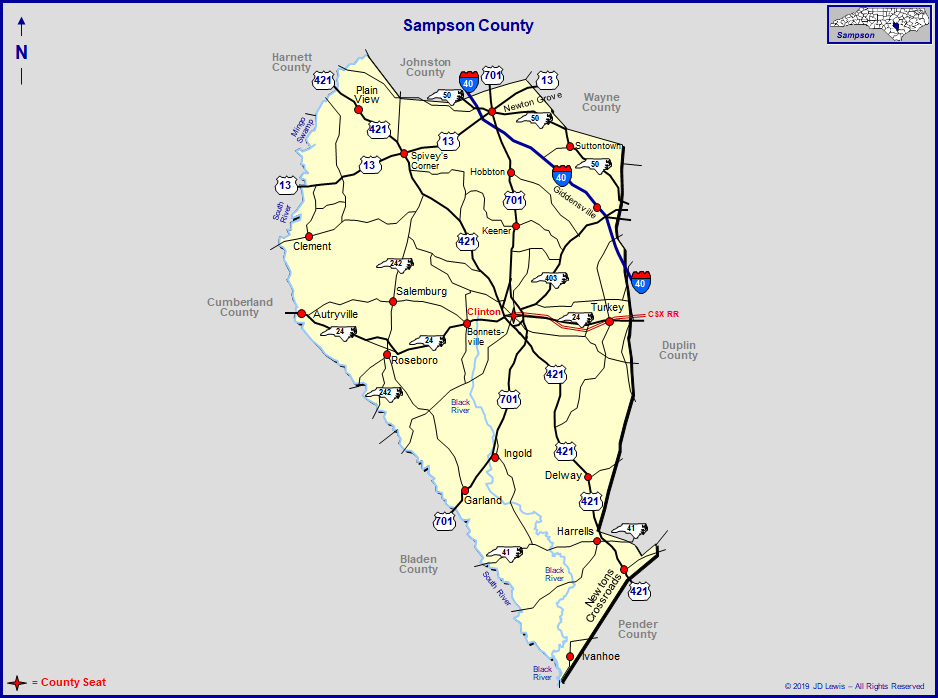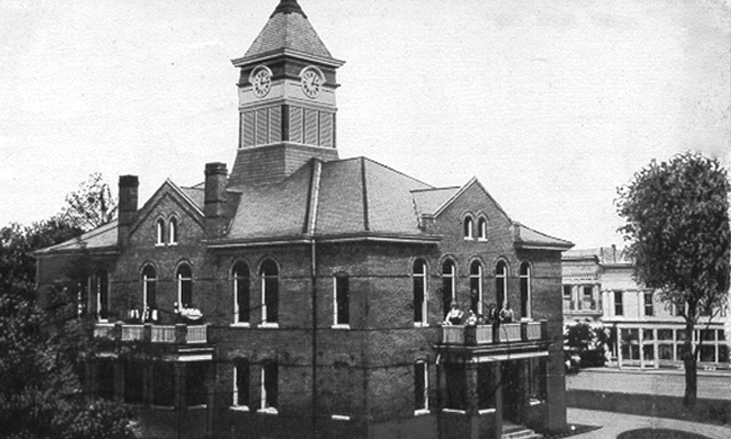 |
||||
|
|
||||
|
|
|
|
|
|
|
|
|
|
|
|
|
|
|
|
|
|
|
|

|
|
|
|
|
|
|
|
|
|
|
|
|
|
|
|
|
|
|
|
|
|
|||
 Sampson County Court House - 1912 Sampson County was formed from Duplin County in 1784. The Act establishing Sampson County directed that the first court be held in the home of James Myhand, at which place the justices were to decide where all subsequent courts were to be held until a court house could be erected. Commissioners were named to select a central location, purchase land, and construct the public buildings. It is probable that the first county seat was simply called Sampson Court House on the public lands of the county. Clinton is the current county seat. The county was named after John Sampson, a noted landowner in the county, member of the colonial House of Burgesses, representing Duplin County from 1761 to 1762, and member of the Executive Council from 1762 to 1775 under Royal Governors Arthur Dobbs, William Tryon, and Josiah Martin. When the American Revolution began, he was an ardent Loyalist that eventually turned to the Patriot cause. Several sources assert he served in the Duplin County Regiment of Militia during the war, but this Author has never found sufficient proof - he was simply too old for active duty, but it is entirely likely that he provided support to the Patriots whenever he was able. Sampson County was established in April of 1784 by the North Carolina General Assembly from an area taken from neighboring Duplin County. Land from Wayne and New Hanover counties would be annexed later. Our early settlers were Scots-Irish immigrants from North Ireland, many of who came to the colony of North Carolina under the protection and inducements of Henry McCulloch, a wealthy London merchant. In 1745, McCullough had obtained grants from the British Crown covering some 71,160 acres of land "lying and situated on the branches of the North East and Black River." The Scots-Irish immigrants were soon joined by descendants of the Swiss colony in New Bern, and sometime later, pioneers from the northern states of New Jersey, Connecticut, and Massachusetts. One of the many Scots-Irish drawn to the county in search of rich farmland and flowing rivers was John Sampson. Sampson was Duplin County’s first Register of Deeds. He served as a Lt. Colonel, and then a Lt. General in the county’s colonial militia before the American Revolution, and was later the first mayor of Wilmington, North Carolina. Emigrating with John Sampson was his fifteen-year-old stepson, Richard Clinton. Like his stepfather, Richard Clinton soon distinguished himself in governmental and military service, serving as Duplin County’s Register of Deeds for ten years, and then in the Provincial Congress held at Hillsborough. In 1776, Richard Clinton organized a company of militia minutemen from upper Duplin County and led them as captain in the defense of Wilmington against the British. He was later appointed Colonel of Calvary and Brigadier General of the Fayetteville District after the war. Upon the establishment of the state government of North Carolina by the Halifax Constitution of 1776, Richard Clinton served as one of the first members of the House of Commons, representing Duplin County. Clinton continued as a representative of Duplin County until the creation of Sampson County in 1784. Clinton secured the passage of the Act creating the new county, and proposed the name "Sampson" in honor of John Sampson, his stepfather and benefactor. Other Sampson County historical figures include: William Rufus King, Ambassador to England and France and Vice President of the United States; Micajah Autry, who battled and died with Davy Crockett at the Alamo; Theophilus Homes, Lieutenant General in the Confederate Army and the highest ranking North Carolinian officer during the Civil War; James Kenan, planter, soldier and legislator; Robert Herring Wright, first President of East Carolina Teachers College; and James Franklin Highsmith, organizer of the Hospital Association of North Carolina and founder of Highsmith-Raney Hospital in Fayetteville. Sampson County is the second largest county in the state: third in the state in farm income, the ninth-largest producer of flue-cured tobacco in the state, and is among the nation's top 120 counties in the production of hogs. Sampson County covers 947 square miles in the coastal plain of North Carolina and is 60 miles long. The topography is gently rolling, even though many flat areas occur. The elevation above sealevel ranges from sixty-three to two hundred feet. Farming is still the principal occupation in Sampson, although the county has considerable industry. Farm income for 1987 was $174,730,091. Sampson County was created in 1784 from Duplin County. Later it annexed portions of New Hanover County and Wayne County to arrive at its present size. Settlers began arriving in the county as early as 1740, moving up South and Black Rivers from the seacoast at Wilmington. The southern end of the county once contained large cotton plantations, but this end of the county today is largely devoted to the growing of pine trees. The dense woods has provided shelter for a large number of deer which make hunting quite good during deer season. Not far from the banks of the Black River at Ivanhoe is the Black River Presbyterian Church, whose first pastor arrived from Scotland, via Wilmington, in a boat up the river. Tradition has it that a part of the lumber from the boat was used to build the first church there. Services were held in Gaelic for many years and the population of the area contained many Scots-Irish. Sampson has eight incorporated towns, of which Clinton, the county seat, is the largest and oldest, having been incorporated in 1852. Other incorporated towns are Roseboro, Autryville, Salemburg, Garland, Turkey, Newton Grove, and Harrells. The town of Lisbon, located on South River, has completely disappeared, a victim of the coming of the railroad. The village of Boone also came and went fairly quickly. Clinton, near the geographical center of the county, was incorporated in 1852. 9,005 people live within the city limits. Clinton is governed by a mayor, city council, and city manager. Garland was incorporated on February 8, 1907. The government of Garland is composed of a mayor, commissioners, a town clerk, and a deputy clerk. The population of Garland is 745 with approximately 350 residential dwellings and 45 small enterprises. The July 1990 census estimate for Newton Grove was 543. Newton Grove is located at the northern end of the county and was incorporated in 1879 and again in 1935. A mayor and fire commissioners comprise the government of Newton Grove. Bentonville Battleground is located approximately five miles outside the city limits. A mayor and board of commissioners govern the 1,441 Roseboro residents. Incorporated in 1891, the town of Roseboro was named after John M. Rose, the Secretary of the Cape Fear and Yadkin Valley Railroad. Roseboro has several diversified industries. The outdoor drama, Micajah, recognized by the Institute of Outdoor Drama, salutes the memory of Micajah Autry, who was born in the town of Autryville. The town of Autry was founded by Captain James L. Autry, in 1890. Autry was instrumental in the location of the Cape Fear and Yadkin Valley Railroad through town. A mayor and five commissioners comprise the town government for the 220 residents and the 17 businesses located throughout the town. Sampson County's most prominent citizen was William Rufus King, ambassador to England and France and Vice-President of the United States. He died in 1853, shortly after taking the oath of office for the Vice Presidency. Another notable citizen was Governor Gabriel Holmes. He was Governor for three one-year terms, from 1821-1824. Other historic figures were Theophilus Holmes, Lieutenant General in the Confederate Army; Richard Clinton (1721-1796), for whom the city of Clinton was named; Colonel John Sampson, an active figure in the Revolutionary War affairs for whom Sampson County was named; Micajah Autry (1794-1836), county native who died with Davy Crockett in the Battle of the Alamo; James Kenan (1740-1810), planter, soldier, legislator; Robert Herring Wright (1870-1934), first president of East Carolina Teachers College; James Franklin Highsmith (1868-1940), organizer of the Hospital Association of NC and founder of a hospital in Fayetteville; and Lauch Faircloth, US Senator from Sampson County. One of Sampson County's greatest assets is the Sampson County Memorial Hospital, located in Clinton. Sampson Community College offers varied courses of study, including occupational programs in both technical and vocational areas. The NC Justice Academy, located in Salemburg, provides criminal justice training for many state and local agencies. |
|||
 |
 |
© 2022 - J.D. Lewis - PO Box 1188 - Little River, SC 29566 - All Rights Reserved